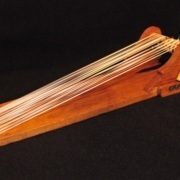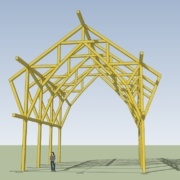First day of class 1971, Architectural Drawing I, 9th graders
At the beginning of my introductory lecture I asked if anyone knew what one could expect to spend for a new home (at the time $26,000 or so). The quick responders were all within $6,000 of the mark. Then Clay Ammon (name not changed to protect the guilty) raised his hand and said “Just shy of $79,000.” His answer was so far into the ether that a group chuckle followed immediately. I saw something in Clay’s eyes which led me to not dismiss his response and so I probed a bit deeper. I remember his explanation like it was yesterday: “A new home today has an average selling price of $26,000, mortgages typically run thirty years, interest rates are at 7.7%, so that adds about $41,000 in interest. I didn’t work in other factors such as tax savings from interest deduction because I didn’t want to hold up the class.” You could have heard a pin drop. I knew it was going to be an interesting year. And it was. It was also about this time that my hair began its slow, but steady march to grey.
In 10th grade Clay signed up for my Mechanical Drawing I class and by then he and I had developed a good rapport. A month or so into the term Clay’s Plane Geometry teacher pulled me aside to discuss Clay’s dismal performance. “Tony, I am pulling my hair out about Clay. I checked with the teacher who had Clay last year in Algebra I and she said he breezed through that class like it was his native tongue. In my class he just sits there staring into space. He does just enough to earn a D. The next day I met with Clay in my office and asked, “What’s the problem with you and Mr. O.?” “I have no problem with Mr. O. I have a problem with plane geometry,” he replied. “You want to explain that?” I implored. “OK,” he began, “It’s a prerequisite for Solid Geometry so I’m forced to take it, but I don’t believe in it.” I laughed. Knowing Clay, I had a pretty good idea where this was headed. “Well, let’s see,” I began, “it’s not a political platform, it’s not a philosophy, and it’s not a religion, so what’s not to believe in, Clay? “We don’t,” he replied, “in a two-dimensional universe and that is exactly what plane geometry deals with; why should I participate in that delusion?” I remember thinking that this was an interesting path of reasoning for a fourteen year old kid. “Clay,” I began, “I’ve read Flatland, too. It’s a novella and it’s satirical. Athletes probably don’t think of conditioning and workouts as the ‘real thing’, but rather as preparation for the ‘real thing’, if you’ll allow that games or contests are ‘real’. Get over yourself and quit being an obstinate jerk.” Pretty much, he did. Mr. O. was thrilled with Clay’s performance through the rest of the year. I said “pretty much” because I, at least, did observe some of Clay’s relapses into jerkiness.
In 11th grade he was in my Architectural Drawing II class. A student teacher I had that semester didn’t hold the same affection for Clay that I held and had tried several times to engage in a bit of intellectual sparring with him. It didn’t go well for the student teacher who himself was sometimes a jerk, but without the substance to back it up. At mid-semester the student teacher’s college supervisor came to observe and evaluate a lecture/presentation on heating and cooling. Today we refer to this as HVAC. Shortly into the lecture the student teacher made the comment, “Of course, everyone knows that heat rises.” At which point Clay’s arm shot up so quickly that I thought his arm would leave his socket. “No, it does not,” Clay claimed. The student teacher then stepped into it with both feet. “Then you’re not very observant, are you Mr. Ammon?” “Perhaps and perhaps not, but I will tell you,” said Clay, “what science tells us. Heat, or more correctly, heat energy, dissipates in all directions. Heated air does rise, but you said heat, didn’t you?”
The student teacher never did become a teacher. Maybe in part because of Clay and other kids like Clay, but mostly because he lacked great enthusiasm for it. So what’s the point of this trip down memory lane? Clay was most certainly hugely gifted, but more importantly he was different. And being different he could be viewed by some as difficult, by some as refreshing — a curse or a blessing. I chose to view him as a blessing, and, for me, he was.
-TZ








